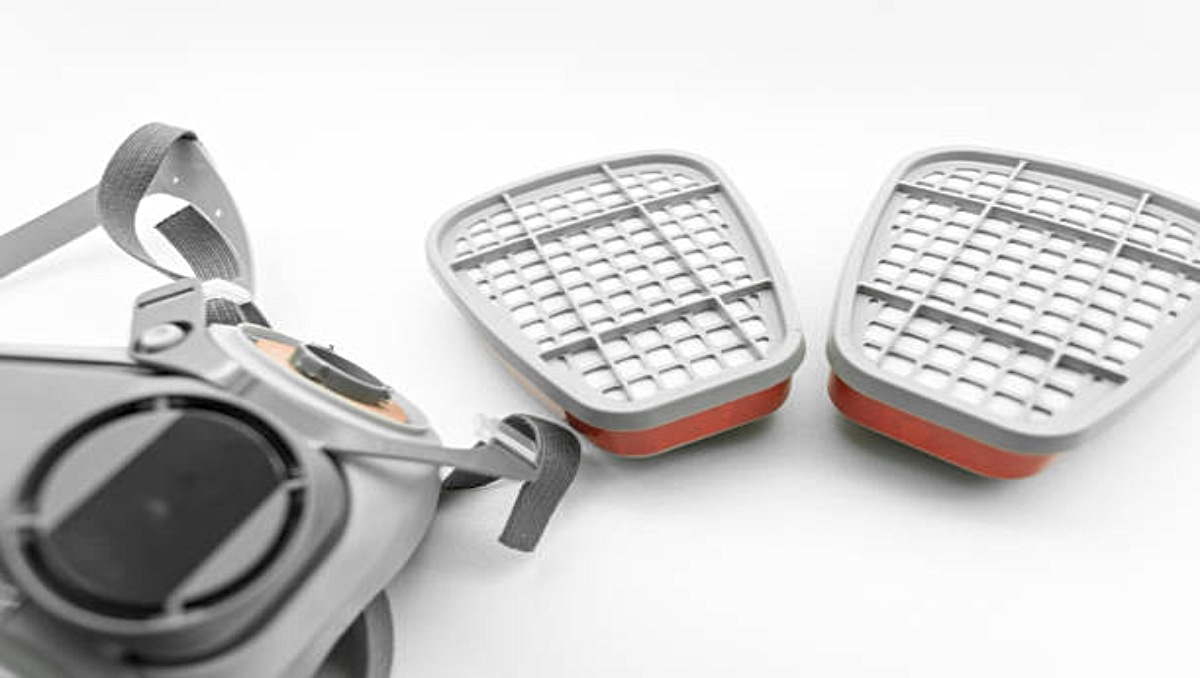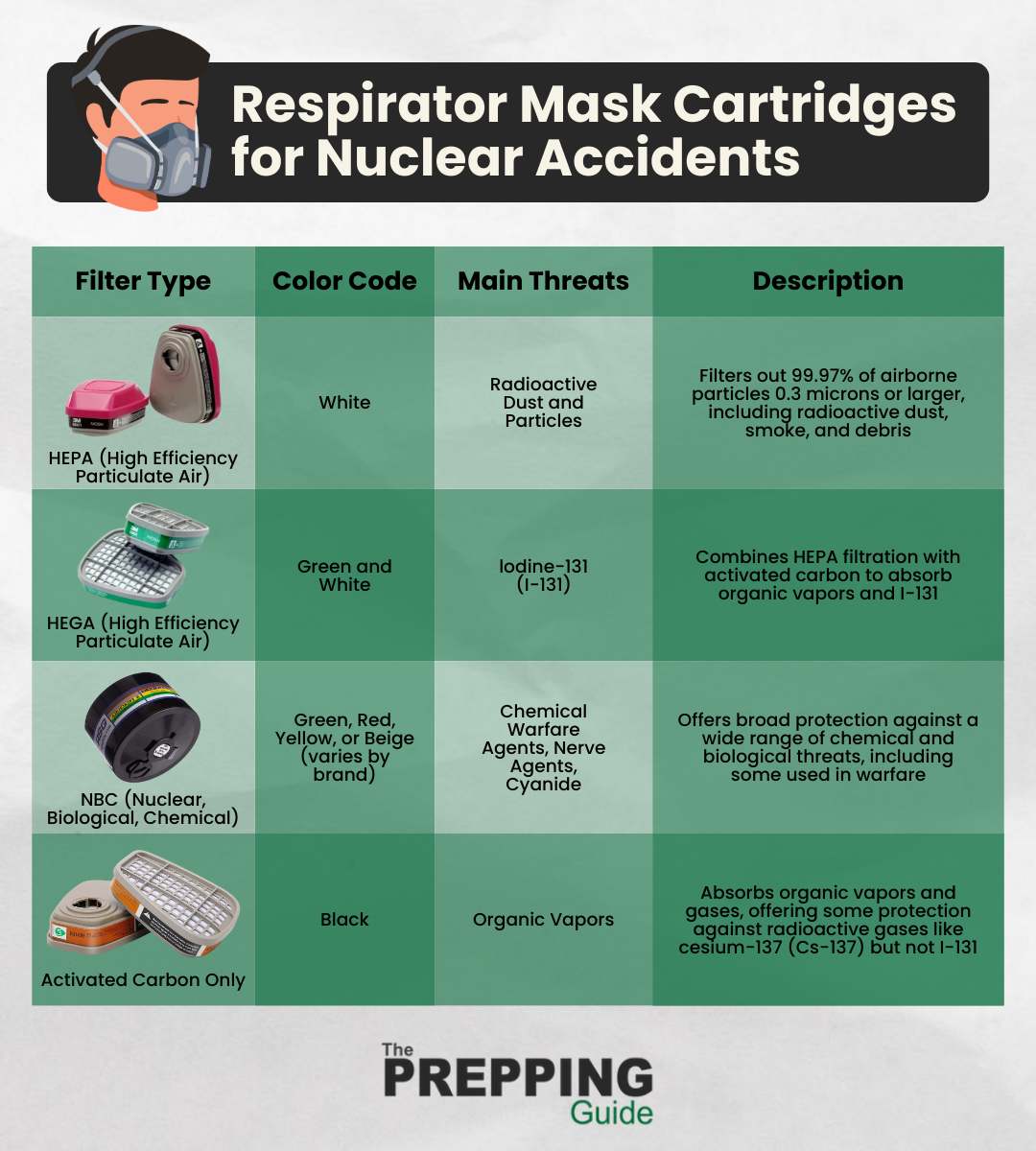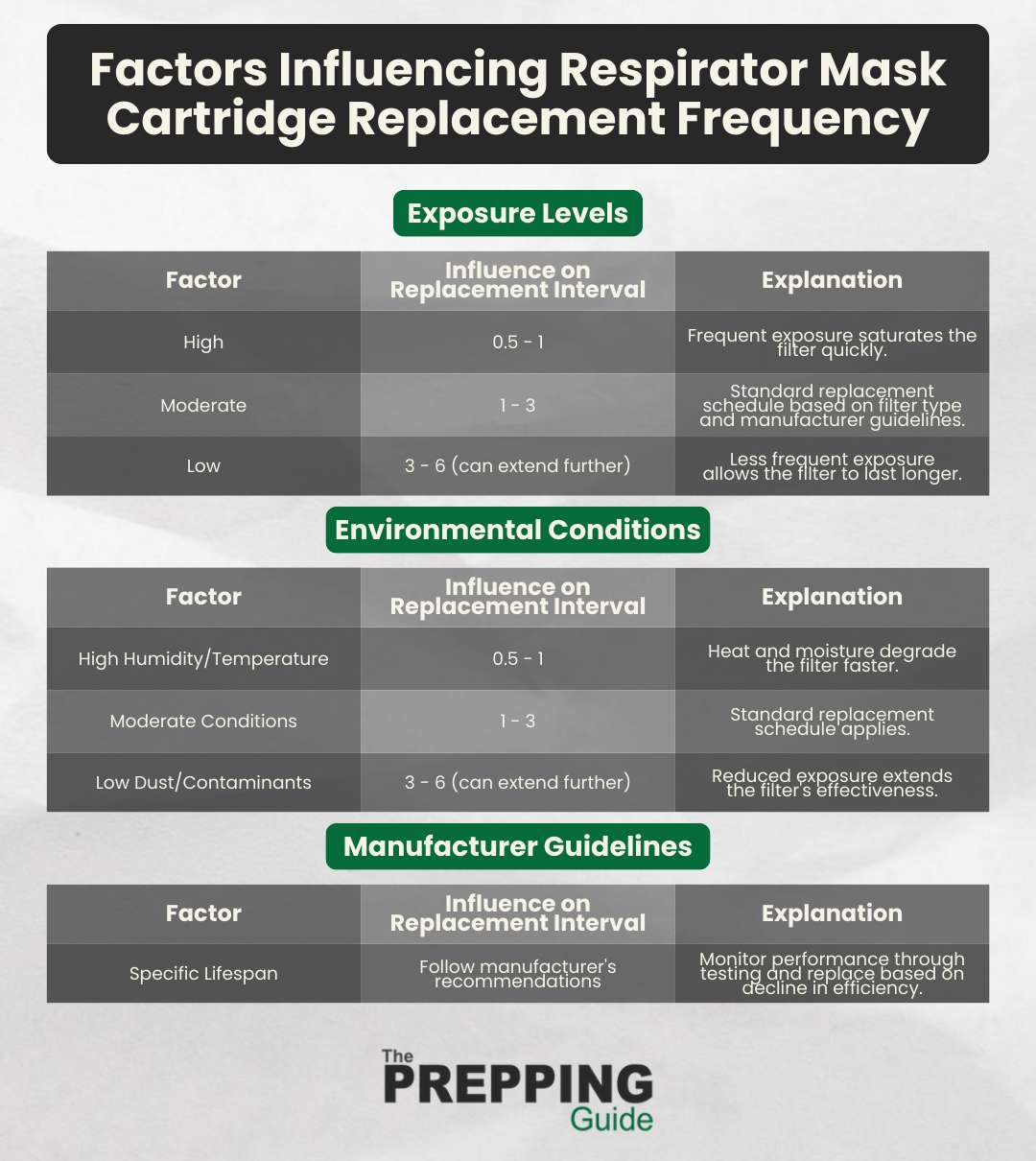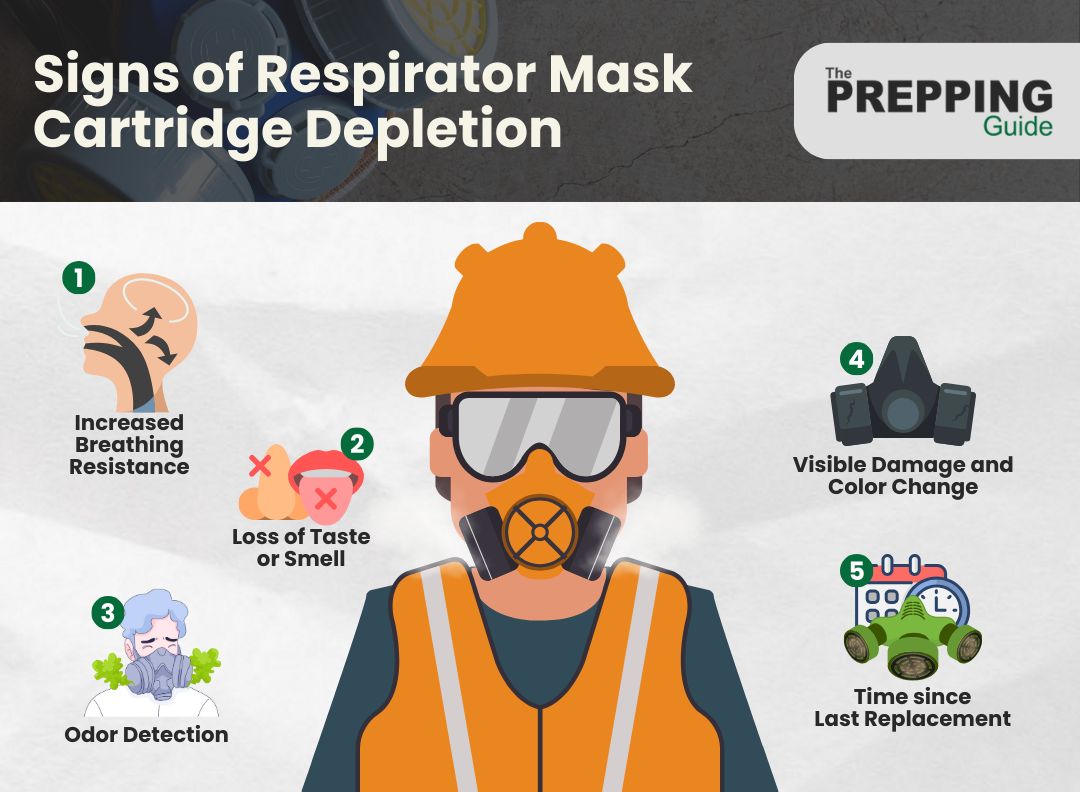The reliability of your respiratory protection is paramount in the realm of nuclear safety. The effectiveness of a respirator mask hinges on its cartridges, tasked with filtering out potentially hazardous particles. But how often should you replace your respirator mask cartridges for nuclear, ensuring your safety remains uncompromised?
The frequency of replacing respirator mask cartridges for nuclear environments depends on the specific contaminants, concentration levels, and the manufacturer’s recommendations. In general, it is advisable to replace cartridges every 1-3 months for frequent users or in high exposure conditions.
This article will delve into the intricate details of respiratory protection during a nuclear catastrophe. We will also explore factors influencing cartridge replacement frequency and equip you with essential inspection practices.
The Role of Cartridges in Nuclear Respirator Masks

You should replace your respirator mask cartridges for nuclear every 3-6 months to ensure optimal protection from radioactive particles. The cartridge lifespan directly affects its filter efficiency and ability to provide radiation protection. Over time, the filters can become saturated with radioactive particles, reducing their effectiveness and potentially exposing you to harmful radiation.
Radioactive particles emitted during nuclear processes can pose serious health risks if inhaled or ingested. Respirator mask cartridges are critical in filtering out these hazardous particles, preventing them from entering your respiratory system. However, as the filters accumulate radioactive material over time, their capacity to trap additional particles decreases.
Replacing cartridges every 3-6 months ensures fresh filters with optimal filter efficiency. This protects against radioactive particles and reduces the risk of exposure to harmful radiation.
Regular filter replacement is essential because even though the cartridges may not appear visibly dirty or worn out, they may no longer offer adequate filtration. By following this recommended schedule for cartridge replacement, you can maintain a high level of radiation protection and safeguard your health while working in nuclear environments.
Explore a comparison of respirator mask cartridges for nuclear accidents through this informative illustration.

Factors Influencing How Often You Should Replace Respirator Mask Cartridges
When determining how often you should replace your respirator mask cartridges for nuclear, there are several key factors to consider.
1. Exposure Levels
Although exposure levels vary, regularly replacing your respirator mask cartridges for nuclear situations is essential. Safety precautions should always be a top priority when dealing with potential health risks and exposure limits in nuclear environments.
Protective equipment, such as respirator masks, is crucial in minimizing radiation effects on the body. By replacing your cartridges regularly, you ensure that the mask effectively filters harmful radioactive particles.
Exposure to high levels of radiation can have severe consequences on your health, including increased risk of cancer and other long-term illnesses. Therefore, following recommended guidelines for cartridge replacement frequency is essential to provide optimal protection during nuclear events.
2. Environmental Conditions
The environmental conditions can be so extreme in nuclear situations that they strain the effectiveness of protective equipment. It is crucial to ensure a proper fit for your respirator mask cartridges to maximize their performance and protect yourself from potential health risks.
Temperature, humidity, and radiation levels can significantly impact the functionality of the cartridges, making regular maintenance and cleaning essential. Extreme temperatures can cause materials degradation, compromising the cartridges’ filtration capabilities. High humidity levels may lead to moisture buildup inside the cartridges, reducing efficiency.
Additionally, radiation exposure can deteriorate the cartridge’s filtering ability over time. To choose the correct cartridge for your specific needs, consider factors such as filtration efficiency, gas or vapor protection capability, and compatibility with your mask model.
Regularly inspecting and replacing worn-out or damaged cartridges is crucial for optimal protection against nuclear hazards.
3. Manufacturer Guidelines
Following manufacturer guidelines is essential for maximizing the effectiveness of your respirator mask cartridges and ensuring optimal protection against extreme environmental conditions in nuclear situations.
Manufacturers play a crucial role in determining the recommended replacement frequency of your cartridges. This frequency may vary depending on factors such as the intensity of usage and the specific cartridge lifespan factors identified by the manufacturer.
The recommended replacement frequency typically considers the expected deterioration of cartridge materials over time and any potential degradation caused by exposure to nuclear contaminants. By adhering to these guidelines, you can ensure that your respirator mask cartridges are always in peak condition and provide reliable protection when needed.
However, it is essential to note that manufacturers’ recommendations are just a starting point. Users are also responsible for assessing their circumstances and adjusting replacement schedules accordingly.
Here’s a summary table outlining the different factors influencing how often you should replace respirator mask cartridges.

Important Regular Inspection Practices
When conducting regular inspections of your respirator mask cartridges for nuclear use, there are two essential practices to follow: visual inspection and functional testing. These standard inspection practices are crucial in maintaining the effectiveness and safety of your respirator mask cartridges in nuclear environments.
Visual Inspection
To inspect your cartridge, check for any signs of clogging, which can significantly affect the filter efficiency. Look for dirt, debris, or discoloration indicating a blocked cartridge.
Additionally, check the expiration date on the cartridges to ensure they are still within their recommended lifespan. It is crucial to replace them before they expire to maintain optimum protection.
Regular maintenance is also essential to prolong the cartridge’s lifespan. Keep them clean and dry when unused, and store them in a cool place away from direct sunlight or extreme temperatures. These simple maintenance tips will help you stay safe and ensure your respirator mask cartridges are always ready for action.
Functional Testing
Functional testing is a crucial aspect of maintaining the effectiveness of your cartridges. It involves performance evaluation and quality control measures to assess their efficiency and determine if they need replacement.
Regular functional testing allows you to gauge how well the cartridges are working and if they meet the required standards for protection against nuclear hazards. This process helps identify any defects or malfunctions that may compromise their performance.
By conducting these tests, you can ensure that your respirator mask cartridges are in good working condition, providing you with the highest safety during nuclear-related activities.
How To Monitor Exposure and Usage
To effectively monitor your exposure and usage of respirator mask cartridges for nuclear, you need to keep track of usage logs and conduct environmental monitoring. By doing this, you can accurately assess the lifespan of each cartridge and ensure timely replacements.

Usage Logs
Ensure you keep a detailed usage log of your respirator mask cartridges for nuclear purposes to quickly track when they need replacement. Usage tracking is crucial in maintaining the effectiveness of your protective gear.
By recording the dates and times of each use, you can establish a maintenance schedule based on the cartridge lifespan. Regularly inspecting the cartridges for signs of wear or damage is essential, but having an organized log allows you to anticipate replacement needs before potential risks arise.
Replacement indicators may vary depending on the specific brand or model, so referring to the manufacturer’s guidelines for accurate information is important. Remember that extended usage beyond recommended limits poses serious risks, as worn-out cartridges may fail to filter out harmful particles effectively.
Environmental Monitoring
Be mindful and monitor the environment for any signs of potential hazards or radioactive substances that may affect the performance of your protective gear. Utilize various monitoring techniques to ensure the safety and effectiveness of your respirator mask cartridges in a nuclear environment.
Radiation detection devices such as Geiger-Muller counters can measure radiation levels in the surrounding area. Air sampling can also provide valuable information about airborne contaminants, allowing you to take appropriate contamination control measures.
Regularly conduct thorough inspections of your work area and equipment to identify any sources of potential contamination. In an emergency, it is crucial to have an effective emergency response plan, which includes regular drills and training sessions.
Proper Storage Practices and Cartridge Disposal
Keep in mind that regularly replacing your respirator mask cartridges is essential for ensuring proper protection and safety from nuclear contaminants. In addition to monitoring the environment, proper storage practices and cartridge disposal play a crucial role in maintaining the effectiveness of your respirator mask.
When it comes to storing your respirator mask cartridges, it is important to follow proper storage techniques. Store them in a cool, dry place away from direct sunlight or extreme temperatures. This will help prevent any damage or degradation of the cartridges, ensuring their longevity and performance.
When disposing of used cartridges, it is vital to use appropriate disposal methods. Check with your local authorities or waste management facilities to determine the specific guidelines for disposing of nuclear-contaminated items. Some jurisdictions may require special handling procedures due to the radioactive nature of these materials.
Remember that improper storage practices and cartridge disposal can compromise the integrity and effectiveness of your respirator mask.
Signs of Cartridge Depletion

When using a respirator mask for nuclear protection, it is crucial to recognize signs indicating cartridge depletion.
1. Increased Breathing Resistance
Take a deep breath and feel the weight of the nuclear air pressing against your chest as you realize it is time to swap out those respirator mask cartridges. This is due to increased breathing resistance. Ensuring the safety and effectiveness of your respirator is crucial in high-risk environments.
It is recommended to follow a regular replacement schedule provided by manufacturers. This schedule typically depends on usage and exposure levels. Ignoring this schedule may lead to health risks as filter efficiency decreases over time, compromising protection against nuclear contaminants.
2. Visible Damage and Color Change
Regular inspection methods are vital in determining the integrity of your cartridges. It is recommended that you visually examine your cartridges before each use. Look for any signs of wear and tear, such as cracks, dents, or discoloration. These can indicate potential issues with the effectiveness of your cartridges.
The lifespan of respirator mask cartridges varies depending on factors like usage frequency and environmental conditions. However, replacing them every 6-12 months is generally advised, even if no visible damage exists.
Proper maintenance is essential to prolong their lifespan. Clean them regularly, following manufacturer guidelines, and store them in a clean, dry place when not in use.
3. Odor Detection
Be aware of any unusual or foul smells when inspecting your respirator mask cartridges, as they could indicate a potential danger that needs immediate attention. Odor detection plays a crucial role in determining the lifespan of your cartridges and the frequency at which they should be replaced.
The filter’s effectiveness depends on its ability to trap harmful chemicals and contaminants; over time, these substances can build up and affect the cartridge’s efficiency. If you detect any strong or persistent odors while wearing your respirator mask, it indicates that the cartridge needs replacement.
Chemical exposure can have serious health consequences, so it is essential to ensure that your respirator provides adequate protection by regularly checking for any signs of odor and promptly replacing the cartridges when necessary.
4. Time Since Last Replacement
Time management is crucial when it comes to replacing respirator mask cartridges for nuclear protection. Ignoring warning signs or neglecting regular maintenance can have severe consequences.
The lifespan of your cartridges depends on various factors such as exposure levels and air quality, but generally, they should be replaced every six months or sooner if needed.
In the video below, SafetyQuip Australia Director Tim Lewis shared, “Replace the filters when the expiry date stamped on the sealed packet has elapsed. Once opened from the original packaging, the maximum use time is 6 months, even if not used.”
Pro Tips for Nuclear Survival
For the best chance of survival in a nuclear event, it is crucial to know these expert tips. In a nuclear emergency, radiation protection is paramount. Personal protective equipment (PPE) is vital in minimizing radiation exposure and ensuring your safety. Emergency preparedness is critical, so here are some tips to help you navigate such a situation.
- Make sure you have the proper PPE for nuclear events. This includes a respirator mask with appropriate cartridges designed explicitly for radioactive contaminants. These cartridges need to be replaced regularly to maintain their effectiveness.
- Familiarize yourself with the different types of radiation and their effects on the body. Understanding how various radiation sources behave can help you make informed decisions about your safety measures.
- Establish an emergency communication plan with your loved ones. A designated meeting place or contact person can provide peace of mind during chaotic times.
Remember, staying informed and being prepared are critical for surviving a nuclear event. Following these pro tips and having the necessary PPE increases your chances of coming out unscathed from such emergencies.
You might be interested to know about the best respirators against particulates.
Radiation Safety: Optimal Respirator Cartridge Replacement
It is crucial to replace your respirator mask cartridges for nuclear protection regularly. By following proper inspection practices and monitoring exposure levels, you can ensure the effectiveness of your mask. Additionally, storing the cartridges and disposing of them properly are essential steps in maintaining efficiency.
Remember, being aware of signs indicating cartridge depletion will guarantee your safety during a nuclear event. So, remember these pro tips for nuclear survival and enjoy peace of mind knowing you’re prepared!
